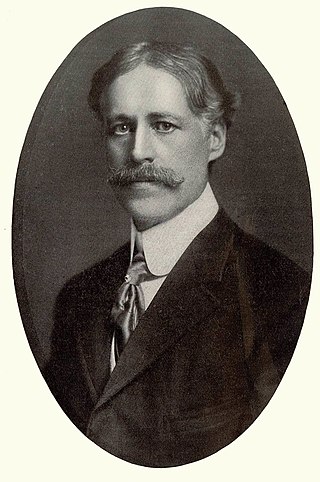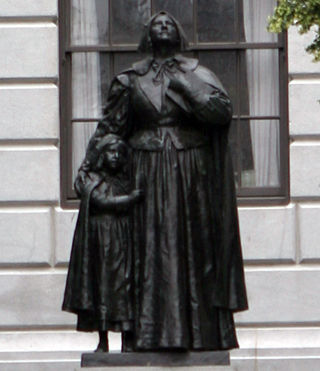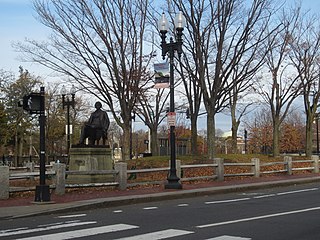
Thomas Ball was an American sculptor and musician. His work has had a marked influence on monumental art in the United States, especially in New England.

Daniel Chester French was an American sculptor of the late nineteenth and early twentieth centuries. He is best known for his 1874 sculpture The Minute Man in Concord, Massachusetts, and his 1920 monumental statue of Abraham Lincoln in the Lincoln Memorial in Washington, D.C.

William Ordway Partridge was an American sculptor, teacher and author. Among his best-known works are the Shakespeare Monument in Chicago, the equestrian statue of General Grant in Brooklyn, the Pietà at St. Patrick's Cathedral in Manhattan, and the Pocahontas statue in Jamestown, Virginia.

Harriet Goodhue Hosmer was a neoclassical sculptor, considered the most distinguished female sculptor in America during the 19th century. She is known as the first female professional sculptor. Among other technical innovations, she pioneered a process for turning limestone into marble. Hosmer once lived in an expatriate colony in Rome, befriending many prominent writers and artists.

Mary Edmonia Lewis, also known as "Wildfire", was an American sculptor.

Cyrus Edwin Dallin was an American sculptor best known for his depictions of Native Americans. He created more than 260 works, including the Equestrian Statue of Paul Revere in Boston; the Angel Moroni atop Salt Lake Temple in Salt Lake City; and Appeal to the Great Spirit (1908), at the Museum of Fine Arts, Boston. He was also an accomplished painter and an Olympic archer.

Anne Whitney was an American sculptor and poet. She made full-length and bust sculptures of prominent political and historical figures, and her works are in major museums in the United States. She received prestigious commissions for monuments. Two statues of Samuel Adams were made by Whitney and are located in Washington, D.C.'s National Statuary Hall Collection and in front of Faneuil Hall in Boston. She also created two monuments to Leif Erikson.

Paul Matisse is an artist and inventor known for his public art installations, many of which are interactive and produce sound. Matisse also invented the Kalliroscope.

Arts on the Line was a program devised to bring art into the Massachusetts Bay Transportation Authority (MBTA) subway stations in the late 1970s and early 1980s. Arts on the Line was the first program of its kind in the United States and became the model for similar drives for art across the country. The first twenty artworks were completed in 1985 with a total cost of US$695,000, or one half of one percent of the total construction cost of the Red Line Northwest Extension, of which they were a part.
Frederick Warren Allen (1888–1961) was an American sculptor of the Boston School. One of the most prominent sculptors in Boston during the early 20th century and a master teacher at the School of the Museum of Fine Arts, Allen had a career in the arts that spanned more than 50 years.
Melzar Hunt Mosman was an American sculptor who made a number of Civil War and Spanish–American War monuments in Massachusetts.
Anne Whitney created two public statues of Samuel Adams. One, made in 1876, resides in the National Statuary Hall Collection in the US Capitol, Washington, D.C. The other, made in 1880, is located in front of Faneuil Hall Plaza in Boston.

John Winthrop is a marble sculpture of John Winthrop by Richard Saltonstall Greenough, installed in the United States Capitol, in Washington D.C., as part of the National Statuary Hall Collection. It is one of two statues donated by the state of Massachusetts. The statue was accepted in the collection by George Frisbie Hoar on December 19, 1876.

The statue of Charles Sumner in Boston's Public Garden is a bronze statue by Thomas Ball, commissioned by the Boston Art Committee to honor Sumner after his death in 1874. The statue was dedicated in 1878.

A statue of Anne Hutchinson by Cyrus Edwin Dallin is installed outside the Massachusetts State House, in Boston, Massachusetts, United States.

Leif Eriksson is an outdoor statue by Anne Whitney at the west end of the Commonwealth Avenue Mall in Boston, Massachusetts, United States. Installed in 1887, it was the first public sculpture to honor the Norse explorer in the New World.

An equestrian statue of George Washington by Thomas Ball is installed in Boston's Public Garden, in the U.S. state of Massachusetts.

General MacArthur Square is a 0.2-acre (810 m2), V-shaped park in Cambridge, Massachusetts, United States, owned by the city. The city's first 24-hour, freestanding public toilet was installed in the park in 2015.

The Minute Man is an 1874 sculpture by Daniel Chester French in Minute Man National Historical Park, Concord, Massachusetts. It was created between 1871 and 1874 after extensive research, and was originally intended to be made of stone. The medium was switched to bronze and it was cast from ten Civil War-era cannons appropriated by Congress.

The Emancipation Memorial, also known as the Freedman's Memorial or the Emancipation Group was a monument in Park Square in Boston. Designed and sculpted by Thomas Ball and erected in 1879, its sister statue is located in Lincoln Park in the Capitol Hill neighborhood of Washington, D.C. The Boston statue was taken down by the City of Boston on December 29, 2020, following a unanimous vote from the Boston Art Commission on June 30 to remove the memorial.

















